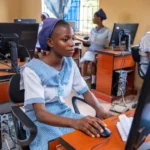In Kenya, environmental collapse is evident in polluted rivers, shrinking forests and erratic rainfall. Even places like the Mau Forest and Lake Naivasha, once lush and flourishing, are now in decline. In response, the Kenyan government rolled out an ambitious restoration campaign.
On December 22, 2022, President William Ruto officially launched the 15-billion-tree planting initiative as part of a new African Landscape Restoration Initiative. This bold national effort explicitly aims to cut greenhouse gas emissions, halt and reverse deforestation, and revive roughly 5.1 million hectares of degraded forest and savanna by 2032.
In rural counties like Nyeri and Mandera, this imbalance takes on surreal dimensions. Monkeys, once forest dwellers, now regularly invade homes and farms, driven by hunger and the loss of habitat.
They raid crops, terrify children, and in extreme cases, have injured residents or behaved aggressively towards women. These bizarre incidents underscore the deepening crisis of habitat loss and the escalating human-wildlife conflict that comes with it.
Amid these challenges, one woman sees an opportunity. Grace Kimaru, an urban and regional planner, is the founder of Foster Green Community-Based Organisation in Nyeri County. Her grassroots organisation focuses on community-powered environmental restoration.
Through campaigns like Grow Trees, Feed Wildlife, launched in 2022, Grace is helping to reduce wildlife incursions and restore ecological harmony by planting fruit-bearing trees near forest edges
Grace’s roots are deeply tied to Nyeri, a region renowned for its expansive forests and rich biodiversity. As a child growing up in its rural villages, she often wondered why her surroundings looked different from places she saw in books or on TV. Why do the cities thrive with well-laid roads and drainage while her community suffers when it rains? One memory stands out: a storm that led to devastating floods – roads submerged, schools closed, and families displaced because of poor drainage systems.
“I kept asking myself who is responsible for creating safer and more organised spaces. That curiosity stayed with me.”
That curiosity later shaped her career path. She pursued a bachelor’s degree in urban and regional planning at Kenyatta University and, later, a master’s in development studies at St. Paul’s University. Though initially interested in quantity surveying, her awareness of the stark contrast between rural neglect and urban development steered her towards planning as a form of justice.
Her education opened doors to conferences, internships, and leadership roles, including her work as Kenya’s Ambassador for the African Smart Cities Innovation Foundation, which champions sustainable urbanisation. She’s also a member of the G100 Women for Sustainable Cities and Communities (SDG 11).
But it was her return home that cemented her path. As forest cover in Nyeri dwindled, drought worsened, followed by a disturbing increase in human-wildlife conflict. The loss of tree canopy had stripped animals of their natural food sources, pushing them into nearby farms.
In 2021, Grace founded the Foster Green Community-Based Organisation to heal the ecological wounds of her community.
“I saw the need for community-led solutions in the face of these crises,” she explains. “It wasn’t enough to talk about sustainability from a distance. We had to live it and lead it from the ground.”
The organisation quickly began addressing the increasingly dire human-wildlife conflict, especially involving velvet monkeys, which had started raiding farms due to the loss of food sources in the wild. She spearheaded the Grow Trees, Feed Wildlife campaign in 2022 to plant fruit-bearing and indigenous trees near forest edges and farmlands to create natural food buffers.
This would reduce the pressure on local farmers and begin restoring ecological balance. According to Grace, the results were significant: reports from the Kenya Wildlife Service and community monitors showed a clear reduction in intrusion by wildlife. Farmers could once again grow their crops in peace.
The word “grow” was intentional, Grace says, because Foster Green’s work lies not just in planting but in the process of growing. The organisation assigns a dedicated monitoring officer to every planting project. They conduct follow-ups with schools, institutions, and partners to track tree survival rates.
“There are groups that say they’ve planted a million trees,” she says. “But most of them never survive. What’s the point of numbers without impact?”
At Foster Green, tree species are selected based on three factors: the local soil, the climate, and the socioeconomic needs of the people. Fruit trees are planted for food security, indigenous trees for biodiversity, and agroforestry trees for farmers.
“We choose the right tree, for the right place, for the right purpose,” she says.
Community ownership is central to the organisation’s success. “We listen. We ask what people need. Then we co-create solutions with them.”
Whether working with schoolchildren, farmers, or youth groups, Foster Green provides training and tools, helping residents see trees not just as decor but as essential to survival. In partner schools, climate clubs have emerged to teach students environmental stewardship.
“We ensure that knowledge about tree planting and tree growing is transferred and multiplied,” she says. “That’s how real change happens.”
On World Environment Day 2025, Grace and her team visited Karindi Primary School, where over 700 students received a fruit tree to care for until graduation.
“When you give a child a tree and make them understand its value, they grow up with that mindset,” she says.
Her long-term vision is even more ambitious: to establish a Green Skills and Innovation Hub for young people to learn practical environmental skills, from climate-smart agriculture to tree nursery management and digital advocacy.
“So many youths are passionate about the environment but don’t know where to begin,” she explains. “This hub would give them the tools, mentorship, and even income opportunities to pursue green careers.”
Despite these achievements, the path has not been easy. Grace has personally funded much of the work. “I’ve used a lot of money on my own,” she admits. “We’ve only gotten a grant once.” Her team of volunteers supports her, but Grace herself wears many hats: strategist, fundraiser, communicator, mobiliser, and field worker.
“This multitasking can sometimes be overwhelming, and it requires good time management and resilience. And of course, you have to maintain team motivation.”
The challenges are not just financial. Grace Kimaru is vocal about the policy gaps hampering environmental action in Kenya. “We have very strong frameworks, but they are weak,” she explains, adding, “weak enforcement when it comes to restoration guidelines and minimal youth inclusion in the planning processes.”
She also laments the lack of recognition for local innovations. “Our Grow Trees Feed Wildlife model has not been recognised even in our own country, and that’s one of the models that has worked at the grassroots level.”
She argues that Kenya’s urban policies are similarly out of step with climate realities. “There are no tree zones in our cities. There is no climate risk mapping. So this leaves our cities and towns vulnerable.”
She contrasts this with regional neighbours: “Rwanda has so many tree zones… Ethiopia is doing really well when it comes to greening. That connection in urban planning and climate action is lacking in our country.”
Even in her own field of urban planning, she sees how political inertia undermines progress. Government housing projects labelled “affordable” are often out of reach. “Planning in Kenya is underrated.”
Balancing all these demands requires discipline. Grace relies on teamwork, delegation, teamwork, and digital tools like Google Calendar to manage her time. She’s intentional about rest, reserving weekends for close friends, weddings, self-care, and laughter.
“When it’s time to rest, I rest. When it’s time to work, I give it my all.”
In the next five years, Grace envisions Foster Green as a national model for ecosystem restoration and youth empowerment. She hopes to influence global policy at platforms like the United Nations, but her heart will always remain in community.
Kenya faces severe environmental crises with polluted rivers, deforestation, and climate change impacts, prompting governmental and grassroots responses. President William Ruto initiated the planting of 15 billion trees by 2032 to curb emissions and revitalize forests. Meanwhile, human-wildlife conflicts escalate as animals invade farms due to habitat loss. Grace Kimaru, founder of the Foster Green Community-Based Organisation, addresses these issues by restoring ecological balance through community-led tree-planting initiatives that aim to mitigate wildlife incursions and support local farmers. Her work emphasizes selecting tree species that suit the region's climate and socio-economic needs, such as fruit trees for food security and indigenous trees for biodiversity.
Grace's commitment to environmental restoration stems from childhood experiences of rural neglect and environmental challenges, which motivated her pursuit of urban and regional planning. Through Foster Green, she fosters community ownership, offering training and resources to locals. This grassroots approach has shown success in reducing wildlife-land conflicts as documented by the Kenya Wildlife Service. However, Grace faces financial and policy challenges, including inadequate government enforcement and recognition of local innovations. Despite these hurdles, she aspires to elevate Foster Green to a national model and influence global environmental policy, while maintaining a profound connection with local communities.






